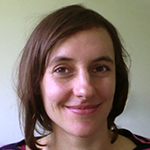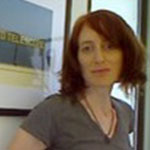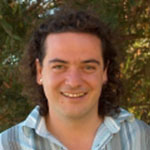Seminars are held at 4:00 PM on Tuesdays in Room F160
on the first floor of the Technological Institute (2145 Sheridan Road) unless otherwise noted
Spring Quarter 2015
| Date | Speaker / Seminar | Host | |
| March 31 |  |
Marilena LoVerde Cosmic background neutrinos are nearly as abundant as cosmic microwave background photons, but their mass, which determines the strength of their gravitational clustering, is unknown. Neutrino oscillation data gives a strict lower limit on neutrino mass, while cosmological datasets provide the most stringent upper limit. Even if the neutrino masses are the minimum required by oscillation data, their gravitational effects on structure formation will nevertheless be detectable in -- and in fact required to explain -- data within the next decade. I will discuss the physical effects of the cosmic neutrino background on structure formation and present a new signature that may be used to measure neutrino mass with large galaxy surveys. |
Claude-André |
| April 7 |  |
Dawn Erb Because faint, low mass galaxies are numerous at high redshifts, their impact on the Universe is expected to be significant. They may host a substantial fraction of global star formation, provide many of the energetic photons needed to reionize the universe, and contribute to the enrichment of the intergalactic medium through the expulsion of metals in galactic outflows. Because of their faintness, however, the properties of these galaxies are difficult to determine. I will discuss a variety of observations aimed at characterizing the physical conditions in low mass galaxies at redshifts z~2-3, the peak epoch of star formation in the Universe, with particular emphasis on the study of galactic outflows in faint galaxies. |
Daniel Angles-Alcazar |
| April 21 |  |
Geoffrey Vasil In spite of outward appearances, many of the partial differential equations used in contemporary fluid dynamics, and the methods used to solve them, contain enough similarities that one may consider their implementation under a very general framework. In this talk, I describe an equation-agnostic apparatus that incorporates a wide range of possible solving schemes, accurate pseudo-spectral spatial representations, and the expressive python language. Flexibility is a requirement, not an afterthought. From a user perspective, setting up a new science problem entails (i) choosing a spectral basis for the domain; (ii) defining variables and parameters; (iii) symbolically entering equations; (iv) making a choice of solver; (v) defining on-the-fly analysis tasks; (vi) running the code. Dedalus runs efficiently on computing platforms ranging from laptops to large-scale supercomputers. In addition, Dedalus is a community development project. We encourage users to contribute functionality and adaptations. Thus far, Dedalus has primarily been used to study problems arising in astrophysical and geophysical fluid dynamics, but there exist many more potential applications. In the talk, I will describe the basic architecture and algorithms. I will also discuss some of the novel scientific applications that Dedalus is making possible. |
Claude-André |
| May 7 Tech F160 12:00pm |
 |
Phil Muirhead The field of extrasolar planets is rapidly evolving. The quest to discover ever more and ever smaller exoplanets has pushed the field in two primary directions: (1) toward a comprehensive assessment of the frequency and statistics of various types of exoplanets -- used to constrain planet formation and evolution theories -- and (2) toward characterizing the composition, atmosphere, and evolution of individual exoplanets as though they were planets in our own Solar System. I will discuss the importance of low-mass stars in this context, emphasizing the phenomenal results from the NASA Kepler Mission, and our efforts to characterize individual terrestrial exoplanets orbiting low-mass stars with existing and new ground-based instrumentation. |
Jason Steffen |
| May 19 |  |
Edwin Bergin In this talk I will focus on two aspects of planet formation that have potential observational signatures that should be present in molecular emission associated with gas-rich disks. First, in the early stages of disk evolution, settling of ice-coated dust grains to the midplane should lead to the sequestration of the disks icy solids into the planet feeding zone. Thus, beyond their snow lines volatiles (CO, H2O, N2) condense and become incorporated into any forming planetesimals. We suggest that over time this process must deplete the upper atmosphere of these important volatile reservoirs. I will present evidence that this process might be active in a nearby disk. This work has broad implications for estimates of disk gas mass and gas dissipation timescales from species such as CO will consequently be intertwined with the timescales of planet formation. In this second part of my talk, I will focus on exploring the possibility that forming gas giants might be detected via disk chemistry using ALMA. Thus I will present a 3D physical/chemical model that includes two point sources: star and accreting protoplanet. With generic assumptions based on planet formation theory and observations, we find that the localized heating of an accreting protoplanet can alter the chemistry in its near vicinity by, for example, releasing volatiles that otherwise would be frozen on grain surfaces. I will show that this effectis present and predicted to be detectable, perhaps opening up the submm/mm-wave to planet searches. |
Farhad Zadeh |
| May 26 |  |
Tom Abel Computational Physics allows us to study extremely non-linear systems with fidelity. In astrophysical hydrodynamics and studies of galaxy formation much of the last two decades we have explored various discretization techniques and found subtle differences in some applications. Interestingly numerical studies of collisionless fluids such as e.g. the collapse of cold dark matter to form the large scale structure of the Universe has only been studied meaningfully with one approach; N-body Monte Carlo techniques. I will introduce a novel simulation approach, and demonstrate its feasibility, that for the first time can study a collisionless system in the continuum limit in multi-dimensions. I will also show this new technique opens a new window in making sense of structure formation as well as plasma physics. In this context we have developed a novel rasterization/voxelization algorithm applicable in computational geometry, computational physics, CAD design and other fields. I show how these approaches allow also for much improved predictions for gravitational lensing, dark matter annihilation, properties of cosmic velocity fields , and many other applications. |
Fred Rasio |
| June 2 |  |
Garth Illingworth When Hubble was upgraded in 2009 with the infrared WFC3/IR camera during SM4 the detection and measurement of galaxies at Cosmic Dawn became possible for the first time. The first billion years is a fascinating epoch, not just because of the earliest galaxies known from about 450 Myr after the Big Bang, but also because it encompasses the reionization epoch that peaked around z~9, as Planck has recently shown, and ended around redshift z~6 at 900 Myr. Before 2009 just a handful of galaxies were known in the reionization epoch at z>6. But within the last 5 years, with the first WFC3/IR survey HUDF09, the HUDF12, CANDELS and numerous other surveys on the GOODS and CANDELS fields, as well as detections from the cluster lensing programs like CLASH and the Frontier Fields, the number of galaxies at redshifts 7-10 has exploded, with some 800 galaxies being found and characterized. The first billion years was a period of extraordinary growth in the galaxy population with rapid growth in the star formation rate density and global mass density in galaxies. Spitzer observations in the infrared of these Hubble fields are establishing masses as well as giving insights into the nature and timescales of star formation from the very powerful emission lines being revealed by the Spitzer IRAC data. I will discuss what we understand about the growth of galaxies in this epoch from the insights gained from remarkable deep fields like the HUDF/XDF, as well as the wide-area GOODS/CANDELS fields, the detection of unexpectedly luminous galaxies at redshifts 8-10, the impact of early galaxies on reionization, confirmation of a number of galaxies at z~7-8 from ground-based spectroscopic measurements, and the indications of a change in the growth of the star formation rate around 500 Myr. The first billion years was a time of dramatic growth and change in the early galaxy population, and the excitement of WFC3/IR will be repeated many times over when JWST launches in just 3.5 years! |
Mel Ulmer |